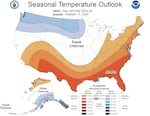
A golden retriever races through the snow during a storm on March 14 in Boulder, Colorado.
Mark Makela
Federal forecasters expect a La Niña climate pattern to form in the coming months, according to a report released Thursday — offering a potential picture of what the weather could look like across the U.S. this winter.
The annual winter outlook report from the National Oceanic and Atmospheric Administration’s (NOAA) Climate Prediction Center details that a La Niña event has a 60% chance of emerging by the end of November. La Niña is characterized by cooler-than-normal ocean temperatures in the Pacific, which typically leads to drier and warmer conditions in the southern tier and cooler, wetter weather in the northern tier of the continental U.S.
This year’s La Niña is expected to be weaker and shorter in duration than ones in previous years, making it somewhat difficult to forecast months in advance.
What federal forecasters do know so far is that large swaths of the South and the East Coast are favored to see warmer-than-average temperatures this winter. Its especially true for Texas and states along the Gulf Coast, like Alabama, Florida, Louisiana and Mississippi, according to NOAA.

The 2024-2025 U.S. Winter Outlook map for temperature shows the greatest chances for cooler-than-average conditions will be in the Pacific Northwest of the U.S.
Meanwhile, odds of cooler-than-normal conditions are higher for the Pacific Northwest to the northern High Plains. That includes states Washington, Oregon, Idaho, Montana, North Dakota, South Dakota, the western Minnesota, and northern Wyoming.
There is also a chance that the Pacific Northwest and parts of Montana and Wyoming will see wetter-than-average conditions in the coming months. Areas in the Great Lakes region are also at risk of a wetter-than-average conditions, with these probabilities being the strongest in portions of Ohio, Indiana and Kentucky.
Further south, there is a likelihood that states bordering the Gulf of Mexico, as well as Texas and southern New Mexico will experience drier-than-average conditions this winter.
NOAA also anticipates widespread moderate to extreme drought to persist across a majority of the Great Plains and portions of the Rocky mountains. Drought is also likely to develop or worsen across the Southwest and Gulf Coast.
Meanwhile, the center said drought conditions are expected to improve — or even possibly end — in parts of the Ohio River Valley, Great Lakes region and portions of the northwestern U.S. in Washington, Oregon and Idaho.